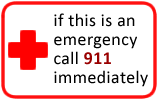Knee Injury
Knee Injury
Does this describe your symptoms? |
Click image for more info |
Definition
Types of Injuries
|
If not, see these topics
First Aid:FIRST AID Advice for Bleeding: Apply direct pressure to the entire wound with a clean cloth. FIRST AID Advice for Penetrating Object: If penetrating object still in place, don't remove it (Reason: removal could increase bleeding). FIRST AID Advice for Shock: Lie down with feet elevated. FIRST AID Advice for Sprained Knee:
|
When to Call Your Doctor |
Call 911 Now (you may need an ambulance) If |
|
|
|
Call Your Doctor Now (night or day) If |
|
|
|
Call Your Doctor Within 24 Hours (between 9 am and 4 pm) If |
|
|
|
Call Your Doctor During Weekday Office Hours If |
|
|
|
Self Care at Home If |
|
|
HOME CARE ADVICE FOR MINOR BRUISE, SPRAIN OR STRAIN |
Treatment of Bruise (e.g., direct blow to knee area):
Apply a cold pack or an ice bag (wrapped in a moist towel) for 20 minutes each hour for 4 consecutive hours. (20 minutes of cold followed by 40 minutes of rest for 4 hours in a row).
48 hours after the injury, use local heat for 10 minutes 3 times each day to help reabsorb the blood.
Rest the injured part as much as possible for 48 hours.
Treatment of Sprains and Strains of Knee:
FIRST AID - Wrap with a snug elastic bandage. Apply an ice pack (crushed ice in a plastic bag covered with a moist towel) to reduce bleeding, swelling, and pain.
Treat with R.I.C.E. (rest, ice, compression, and elevation) for the first 24 to 48 hours.
REST the injured leg for 24 hours. You may return to normal activity after 24 hours of rest if the activity does not cause pain.
Continue to apply crushed ICE packs for 10-20 minutes every hour for the first 4 hours. Then apply ice for 10-20 minutes 4 times a day for the first two days.
Apply COMPRESSION by wrapping the injured part with a snug, elastic bandage for 48 hours. If you experience numbness, tingling, or increased pain in the injured part, the bandage may be too tight. Loosen the bandage wrap.
Keep injured leg ELEVATED and at rest for 24 hours. Put your leg up on a pillow and stay off your feet as much as possible.
Pain Medicines:
For pain relief, take acetaminophen, ibuprofen, or naproxen.
Acetaminophen (e.g., Tylenol):
Take 650 mg by mouth every 4-6 hours. Each Regular Strength Tylenol pill has 325 mg of acetaminophen.
Another choice is to take 1,000 mg every 8 hours. Each Extra Strength Tylenol pill has 500 mg of acetaminophen.
The most you should take each day is 3,000 mg.
Ibuprofen (e.g., Motrin, Advil):
Take 400 mg by mouth every 6 hours.
Another choice is to take 600 mg by mouth every 8 hours.
Use the lowest amount that makes your pain feel better.
Naproxen (e.g., Aleve):
Take 250-500 mg by mouth every 12 hours.
Use the lowest amount that makes your pain feel better.
Extra Notes:
Acetaminophen is thought to be safer than ibuprofen or naproxen in people over 65 years old. Acetaminophen is in many OTC and prescription medicines. It might be in more than one medicine that you are taking. You need to be careful and not take an overdose. An acetaminophen overdose can hurt the liver.
Caution: Do not take acetaminophen if you have liver disease.
Caution: Do not take ibuprofen or naproxen if you have stomach problems, kidney disease, are pregnant, or have been told by your doctor to avoid this type of medicine. Do not take ibuprofen or naproxen for more than 7 days without consulting your doctor.
Before taking any medicine, read all the instructions on the package
Expected Course: Pain and swelling usually begin to improve 2 or 3 days after an injury. Swelling is usually gone in 7 days. Pain may take 2 weeks to completely resolve.
Call Your Doctor If:
Pain becomes severe
Pain does not improve after 3 days
Pain or swelling lasts more than 2 weeks
You become worse
And remember, contact your doctor if you develop any of the "Call Your Doctor" symptoms.
Updated:
March 22, 2017





